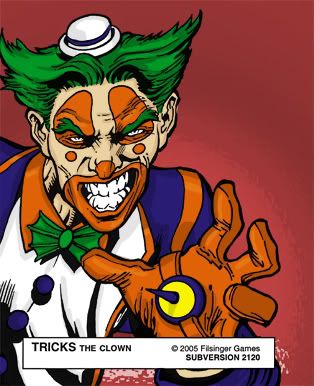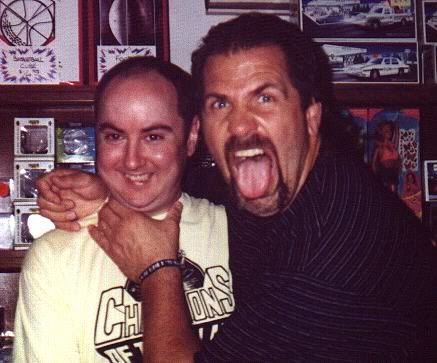|
|
Post by LWPD on Apr 22, 2007 7:27:50 GMT -5
The CotG HOF Ballots have now been fully vetted for the elimination of duplicates and the five year retirement rule. There will be four separate ballots issued based upon each wrestlers debut in the GWF. As it stands now each ballot will offer between 46 to 40 candidates. Special thanks to Jim Steel and Troy...without whom this arduous process would have never been completed. As a community we all own them a debt of gratitude for investing their time, energy and patience into this. The final issue regarding the election process involves the percentage of affirmative (yes) votes that will be allowed (per ballot separation) for this Final Ballot Phase (which is one phase before induction). In keeping in line with the previous Institution Building Poll on Thresholds...75% was established as the baseline. In that sense the process is very similar to that used by the Baseball Writers Association of America. As a frame of reference baseball will typically issue an Induction Ballot of 25-40 candidates with 10 maximum affirmative votes. Remember that not every voter records ten affirmative votes...the guidelines simply provide for the maximum number allowed.
BBWA Baseball Hall of Fame Balloting Over The Last 8 Years
2006 29/10 34.48%
2005 27/10 37.0%
2004 32/10 31.2%
2003 33/10 30.3%
2002 28/10 35.7%
2001 32/10 31.2%
2000 30/10 33.3%
1999 29/10 34.48%For reference the EC to 2086 Ballot will feature 46 candidates. How a percentage breaks down can make a core difference in the overall results:
Max of 37% = 17 affirmative votes
Max of 35% = 16 affirmative votes
Max of 33% = 15 affirmative votes
Max of 30% = 14 affirmative votes
Max of 25% = 12 affirmative votesI'm not too concerned with the number being overly generous for those making the final ballot...but in order to calculate the results I do need a final number to go by based upon a percentage. We can revisit said percentage before the Final Induction phase. |
|
|
|
Post by theringmaster on Apr 22, 2007 11:49:41 GMT -5
33%
|
|
|
|
Post by Cory Olson on Apr 22, 2007 14:29:16 GMT -5
I went with the max. of 37%. A LWPD said, you wouldn't have to vote for that many candidates on a ballot, but you could if you felt that many were deserving to be in the HOF.
|
|
|
|
Post by stephenvegas on Apr 22, 2007 14:47:50 GMT -5
37%
|
|
|
|
Post by steefposton on Apr 22, 2007 15:12:06 GMT -5
I like 33% for 2 reasons:
1st- I can't see any situation where more than 1/3 of anyone would be worthy of induction (baseball allows that % of votes for people on the ballot, but not everyone is on the ballot!)
2nd- I really like the idea of forcing people to make tough choices. I have 1 vote left, do I give it to Lord Nexus or Badger? I think that those kind of tough choices will leave us with a Hall of FAME and not a hall of VERY GOOD.
|
|
|
|
Post by tystates on Apr 22, 2007 15:22:31 GMT -5
Not sure if I'm getting what you want here. If you have established the 75% needed to be inducted I don't get what this poll is for.
For baseball, whatever the total number of votes are, 75% of that is needed for induction. So when voting is over you count the total number of ballots cast. Then a wrestler has to be on 75% of them to be inducted.
Alright. I might have figured it out. I think it is clearer to say a voter can make five votes, or eight, or 10, rather than expressing it as a percentage of the number of candidates on the ballot.
So if I am reading this chart right:
Max of 37% = 17 affirmative votes
Max of 35% = 16 affirmative votes
Max of 33% = 15 affirmative votes
Max of 30% = 14 affirmative votes
Max of 25% = 12 affirmative votes
This means if we choose 37% that we can vote for 17 names on the EC to 2086 ballot. I got to think that is way to high.
Another thing I'm noticing. This chart shows how many you can vote for from EC to 2086. But if another ballot has more of less candidates then the percentage will give a different number of votes. I think it should be the same throughout. I'm thinking five is good but wouldn't want to see more than 10 that you can vote on from any ballot.
Here is another thought. You said four separate ballots. Are you going to let for example 10 votes off each one? I gather you are separating for ease but I think they should be looked at together for purposes of how many people you can vote. Otherwise a weak ballot that allows 10 people to voted on could see wrestlers less than deserving finding a way in because there wasn't a lot else to vote for on that ballot.
|
|
|
|
Post by LWPD on Apr 22, 2007 17:22:01 GMT -5
Ty you seem to have many questions...but questions are good for the process. Just to clarify the phase we are discussing here will create a 'Final Ballot' for the HOF Induction process...it does not constitute the Induction itself. This format was established after a vote in the How Many Phases Should There Be To Induction? poll. The creation of a Final Ballot has two benefits: i. it creates a building block for any future HOF cycles (at this point nothing exists other than an absolute grouping of candidates) and ii. it sets the stage for a 'final induction vote' that can again be tailored and adjusted in retrospect after the initial vote takes place. This allows us to make the rules concerning Final Induction as relaxed or stringent as the community wants...with a definitive template to work from (right now all that exists is an abstraction). Correct. This was the threshold chosen by the majority of those who participated in the poll regarding Thresholds. Correct. Note that regardless of whatever absolute number is chosen it will ultimately represent a percentage. These percentages are reflective of numbers the BBWAA have used for past ballots. Since BBWAA ballots fluctuate in the number of eligible candidates they allow from year to year...it is best to study said percentages as our reference. That's certainly your right...but that contradicts the practical findings of the BBWAA system...which has substantial experience in this area. Note that the number of affirmative votes any one individual voter choses to cast is self determined. Just because a voter has the 'ability' to vote for say 33% of the candidates...it doesn't mean he will chose to do so. For any candidate to numerically reach 75% is no easy task. Yet even if it was....this phase concerns the creation of a Final Ballot and not an actual induction. The ratio for the HOF Induction phase will be revisited before we move on. This was an excellent question...one I was planning on running a poll on. The number of eligible candidates on the four ballots came out slightly uneven in number because more eligible candidates exist from the earlier years (due to the five year retirement requirement). I see the different numbers as manageable if they are guided by a rule of equal percentage...if the voters of the BBWAA can work with variance I don't see why this community couldn't either. Yet that should and does require a community vote and a poll will be created. Let me say at the outset that the alternative approach would be for candidates to be shifted from one ballot era to another in order to equalize the number of eligible candidates in each era. While the benefit is that there would be a uniform (or near uniform) number of candidates on each ballot...it would come at the expense of removing the 'shifted candidates' from being judged among their peers. In other words it creates a tampering effect that alters their entire candidacy. If you go back to past threads you'll see it was long ago decided that the ballots for this initial phase would be split up by era. It works best for building a comprehensive CotG history (which is the main goal of this project) with peer measured against peer from the same debuting time frame. By necessity the unified candidacy approach will be in full effect for the Final Induction phase...which is one of the reasons why a generous Final Ballot allowance is attractive...it alleviates any 'weak ballot' concerns. |
|






